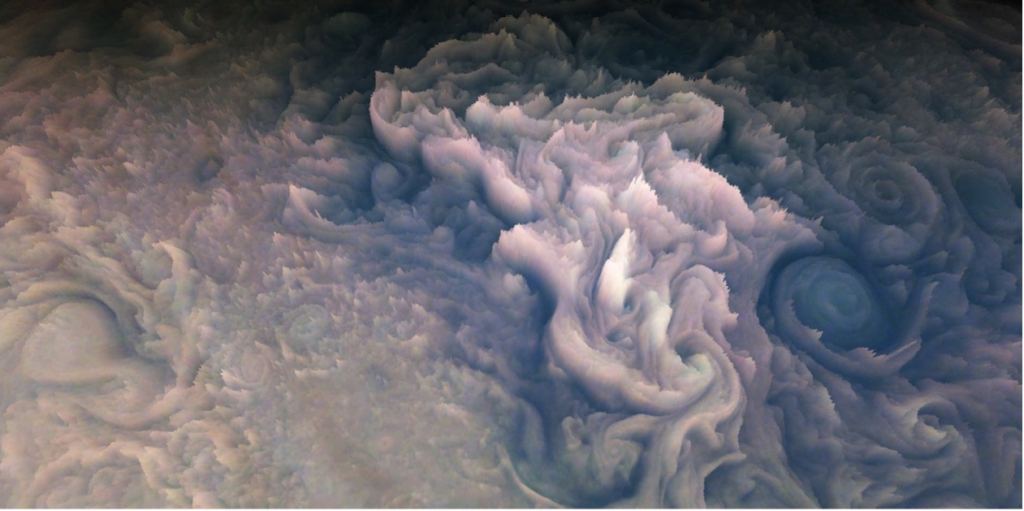In July 2016, NASA’s Juno space probe reached Jupiter, becoming the second spacecraft in history to orbit the gas giant (the first being the Galileo probe that orbited Jupiter from 1995 to 2003). The data it has sent back has led to new revelations about the Jovian atmosphere, magnetosphere, gravitational field, structure, and composition. While its primary mission was intended to only last until 2018, a mission extension means that Juno will continue to orbit Jupiter’s poles (a perijove maneuver) and send back stunning images and data until 2025.
Recently, a team of citizen scientists led by mathematician and software developer Gerald Eichstädt used images taken by the probe’s visible-light camera/telescope (the JunoCam) to create a 3D animation of Jupiter’s upper atmosphere. Eichstädt’s animation was presented at the 2022 Europlanet Science Congress (EPSC), which took place from September 18 – 23 in Granada, and shows the relative heights of the cloud tops of Jupiter that reveal delicately textured swirls and peaks. Eichstädt’s work also showcased the potential for citizen science and public engagement with today’s missions.
The Junocam was initially put on board to increase public engagement by taking raw images that are made available in a public gallery. Citizen scientists can then download the images, process them, upload the finished creations, and share them with the world. In this case, a worldwide team of citizen scientists, working closely with professional astronomers and the Juno team, demonstrated that JunoCam data could also be used to create stunning visuals and valuable science.
As Eichstätd stated in a Europlanet Society press release: “The Juno mission provides us with an opportunity to observe Jupiter in a way which is essentially inaccessible by Earth-based telescopic observations. We can look at the same cloud features from very different angles within only a few minutes. This has opened up a new opportunity to derive 3D elevation models of Jupiter’s cloud tops.
The images of the wonderful chaotic storms on Jupiter seem to come to life, showing clouds rising at different altitudes. ” The images used to create the animation were taken during Juno’s 43rd close flyby of Jupiter (its 43rd perijove maneuver), which took place on July 5th, 2022, when the probe was at a nominal altitude of 13,536. 3 km (8,411 mi) above Jupiter’s cloud tops.
These visible-light pictures once again revealed intimate details about Jupiter’s atmosphere, including the swirling cloud formations near the planet’s north pole, reaching depths of over 50 km (30 mi) and hundreds of km in diameter. A close-up view of these images can be seen in the video posted above (courtesy of space animation artist Celestial). In Jupiter’s dense atmosphere, illumination is most intense for clouds in the upper layers.
In contrast, more light is absorbed by clouds deeper down (especially the methane-rich ones) before being scattered back to space. By analyzing how sunlight is reflected and scattered by different parts of the atmosphere, the team created a 3D visual representation of the elevation of the cloud tops, noting the spiky pillars within the swirls. By measuring the relative heights of these pillars, scientists will gain a better understanding of their composition.
Said Eichstätd: “From theoretical models, the clouds are expected to be composed of different chemical species, ammonia, ammonium hydrosulphide, and water ice from top to bottom. Once we calibrate our data thanks to other measurements of the same cloud tops, we will test and refine the theoretical predictions and have a better 3D picture of the chemical composition. ” Further Reading: Europlanet Society The post A Fascinating Look at Jupiter’s Clouds Where the Light Intensity is Converted Into 3D appeared first on Universe Today.
.
From: universetoday
URL: https://www.universetoday.com/157776/a-fascinating-look-at-jupiters-clouds-where-the-light-intensity-is-converted-into-3d/



